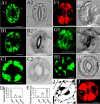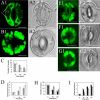The dynamic changes of tonoplasts in guard cells are important for stomatal movement in Vicia faba
- PMID: 16244153
- PMCID: PMC1283759
- DOI: 10.1104/pp.105.067520
The dynamic changes of tonoplasts in guard cells are important for stomatal movement in Vicia faba
Abstract
Stomatal movement is important for plants to exchange gas with environment. The regulation of stomatal movement allows optimizing photosynthesis and transpiration. Changes in vacuolar volume in guard cells are known to participate in this regulation. However, little has been known about the mechanism underlying the regulation of rapid changes in guard cell vacuolar volume. Here, we report that dynamic changes in the complex vacuolar membrane system play a role in the rapid changes of vacuolar volume in Vicia faba guard cells. The guard cells contained a great number of small vacuoles and various vacuolar membrane structures when stomata closed. The small vacuoles and complex membrane systems fused with each other or with the bigger vacuoles to generate large vacuoles during stomatal opening. Conversely, the large vacuoles split into smaller vacuoles and generated many complex membrane structures in the closing stomata. Vacuole fusion inhibitor, (2s,3s)-trans-epoxy-succinyl-l-leucylamido-3-methylbutane ethyl ester, inhibited stomatal opening significantly. Furthermore, an Arabidopsis (Arabidopsis thaliana) mutation of the SGR3 gene, which has a defect in vacuolar fusion, also led to retardation of stomatal opening. All these results suggest that the dynamic changes of the tonoplast are essential for enhancing stomatal movement.
Figures








References
-
- Allen GJ, Chu SP, Harrington CL, Schumacher K, Hoffmann T, Tang YY, Grill E, Schroeder JI (2001) A defined range of guard cell calcium oscillation parameters encodes stomatal movements. Nature 411: 1053–1057 - PubMed
-
- Ashford AE, Allaway WG (2002) The role of the motile tubular vacuole system in mycorrhizal fungi. Plant Soil 244: 177–187
-
- Blatt MR (2000) Cellular signaling and volume control in stomatal movements in plants. Annu Rev Cell Dev Biol 16: 221–241 - PubMed
-
- Blatt MR (2002) Toward understanding vesicle traffic and the guard cell model. New Phytol 153: 405–413 - PubMed
Publication types
MeSH terms
Substances
LinkOut - more resources
Full Text Sources
Molecular Biology Databases

